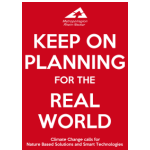
|

|

|
|
|
KEEP ON PLANNING FOR THE REAL WORLD Since the beginning of industrialisation, the concentration of greenhouse gases in the atmosphere has been steadily increasing due to human influences. Currently, an increase of greenhouse gases in the atmosphere of almost 50 percent compared to the level of pre-industrialisation has been recorded. Without taking into account the increase in greenhouse gases in the atmosphere, the observed warming of the climate system cannot be explained. The problem of climate change is therefore caused by humanity itself and can therefore be counteracted by humanity itself. However, this is a long-term process with a high investment of resources with very limited immediate, short-term results – so it seems little wonder that it is only getting off the ground very slowly. It is, therefore, all the more important to take selective countermeasures wherever possible. If measures against climate change are combined with modern technologies, additional short-term effects can be achieved, such as an increase in the (urban) quality of life, a mitigation of traffic problems or savings through reduced resource consumption. These and other aspects can be achieved under the umbrella of the Smart City, and Mannheim has decided to become a Smart City and is on a successful way: as the first German city, Mannheim received the #EUMissionLabel as part of the “100 climate neutral and smart cities by 2030” programme by the EU Commission. But what does this step mean for the citizens on the one hand, and for planning and administration on the other? Smart Cities use the potential of digital technologies and intelligent data networks to increase the quality of life simultaneously moving into the future in a resource-saving and efficient way. Smart cities collect vast amounts of data, which can be used to inform policy making and city planning leading to more effective urban and regional governance. Also the economic aspect must be considered as Smart Cities can attract investments and businesses, creating job opportunities and stimulating economic growth. They can also foster innovation and entrepreneurship through technology hubs and incubators. This contributes to the development of services by delivering public services more efficiently, such as healthcare, education, and public safety. This enhances the overall well-being of residents and can contribute to social development. The cornerstones in Mannheim’s smart city model are (1) mobility transparency, (2) climate resilience and (3) resource efficiency. At the heart of all components are sensor networks that generate and aggregate the data necessary for the application of the smart city model. (1) Mobility transparency: With a specially designed mobility model, both individual traffic and stationary traffic are monitored and managed on a sensor basis. The use of public spaces by traffic is controlled and limited, and an incentive-based traffic control system ensures that preference is given to environmentally compatible modes of transport, thus creating an intuitive tendency towards a decline in motorised private transport. (2) Climate resilience: A widely ramified, extensive sensor measurement network monitors environmental data throughout the city and brings it together in an environmental data platform. Green spaces are managed digitally and the adaptation of urban development to the consequences of climate change is also carried out with digital tools. In this way, it can be ensured that future climatic requirements will also be managed. (3) Resource efficiency: Resource consumption is digitally recorded and compiled into a dashboard. This includes not only consumption per se, but also the generation of waste, which in turn is a valuable resource in its own right and can be fed back into the cycle. Energy management at neighbourhood level ensures the targeted and economical use of raw materials. In addition, a new generation of heat pumps to increase the solar contribution margin seems to be required. Clustering promotes progress, and Mannheim has been leading the way in this area for some time: The regional Mannheim Medical Technology Cluster promotes the networking of companies, start-ups, clinics and research in all sub-sectors of the healthcare industry. With the initiation of the Network Smart Production, Mannheim has created an innovation platform. Industry, research and solution providers are brought together and can initiate a variety of B2B and funded applied research projects. The combination of a strong production location and a strong green tech location makes Mannheim a hotspot of the green and smart industry. Science, companies and civil society, thus, have the opportunity to recognise challenges in the areas of environmental and climate protection at an early stage and to develop possible solutions for them together in a participatory approach. The Social Economy Cluster includes companies that combine entrepreneurial thinking, free-market action and social goals. In this way, people are supported on a small scale at the municipal level to implement their ideas for a better world and a better city in a way that is profitable for everyone involved. As an initiative towards a city of the future, sMArt City Mannheim GmbH is a joint venture between the municipal holding company MKB Mannheimer Kommunal Beteiligungen GmbH and MVV Energie AG. As a company within the municipal group of companies, the joint venture will advance decarbonisation and digitisation in Mannheim. Last but not least, Mannheim’s Smart City movement is strongly supported by a university landscape with a network of co-operating universities with diverse and interdisciplinary research focus. |
 |
 |
 |
 |
 |
||||||
 |
 |
 |
 |
 |
  |
|||||
 |
 |
 |
 |
 |
 |
|||||

